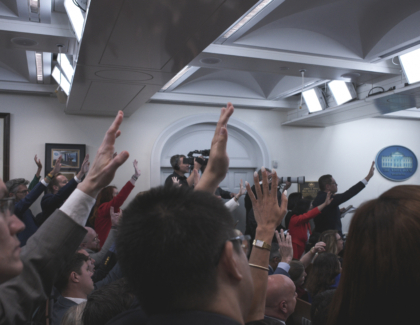Sign up for the daily CJR newsletter.
In January, a pair of Reuters journalists spotted an unusual court motion filed by Johnson & Johnson. The pharmaceutical giant is one of seven companies that make a product known as pelvic mesh, used to treat conditions like urinary incontinence and uterine prolapse, that is at the center of a major wave of personal injury litigation. Johnson & Johnson claimed in its motion that women were receiving unsolicited phone calls from unidentified people to join the lawsuits—and asked the court to allow the company to investigate those calls.
That discovery prompted Reuters to launch an investigation of its own. The result—“The Lien Machine,” by legal columnist Alison Frankel and product liability reporter Jessica Dye, published last week—is part health story, part buyer-beware tale, and an all-around compelling read about how a little-known industry can reap an outsize share of the settlements paid to injured women.
“We found ourselves reporting on this industry that we didn’t know existed,” said Frankel.
That industry is known as medical funding, and as Frankel and Dye explain it, this is how it operates:
Medical funders, often working through go-betweens… or doctors’ billing services, purchase medical bills at a deep discount from physicians, hospitals and others who have provided care to patients involved in personal injury litigation. Some medical funders also provide “concierge care” to these patients, fronting them travel and expense money at a high rate of interest.
Patients who rely on medical funders tend to be poor. They either lack private insurance or can’t afford to pay cash deductibles or out-of-network fees charged by their doctors.
When a patient’s lawsuit settles, the medical funder stakes a claim to part of the settlement by placing a lien for the full amount of the surgical bill. The funder’s profit lies in the difference between what it pays the medical provider to buy the bill and what it is able to recover from the patient’s settlement.
These medical liens sometimes spiral to as much as 10 times what private insurers or government programs like Medicaid would pay for the same procedures…
It’s a complicated operation, which made telling the story a challenge. Product liability stories usually involve “an evil manufacturer versus evil plaintiffs’ lawyers,” Frankel said, adding this one was “so much more subtle because so many more people are making money at the expense of the plaintiff.”
Through the story of Traci Rizzo, a 42-year-old mother from Gulf Shores, Alabama, Frankel and Dye show how the deals work. Several years ago, Rizzo had three mesh implants, and a range of complications followed. She resorted to removal surgery, and signed an agreement with a medical funding company. The surgeon who performed the operation was paid $17,000 by the funding company; Rizzo’s insurer, Blue Cross and Blue Shield of Alabama, told Reuters it typically pays doctors between $900 and $1,300 for such surgeries.
The funder eventually claimed a lien against Rizzo for more than $60,000 to cover the surgery, travel, and medications. When she raised a fuss, arguing that that represented nearly a $40,000 profit to the company, the lien was cut in half—an amount Rizzo argues is still too much. To put the size of that lien in perspective, Reuters reports that in one recent mass settlement, the average award per patient was about $40,000. (Reuters reported that the owner of the funding company did not respond to requests for comment. They cite other proponents of the industry who argue that medical funders provide patients faster access to good doctors, and that their profits represent a fair return for money advanced against a settlement that may never materialize.)
The Reuters piece has prompted some discussion online since it appeared, but there’s little sign of an official response. The journalists asked several state attorneys general whether the medical funders fall under their regulations. So far, none of the AGs or the federal Consumer Financial Protection Bureau have said they have the authority to regulate them. “The medical funding business is attractive precisely because it isn’t regulated,” Frankel observed.
Could the Affordable Care Act, designed to make insurance available even to low-income people, dry up the medical funding business? Probably not: Out-of-pocket expenses resulting from high deductibles and high coinsurance, plus doctors who opt out of the insurance system, will likely continue to provide opportunities for the industry. That means there’s a need for more oversight—reason enough for Frankel and Dye to stay on the case, and other jouranlists to follow the path that they blazed.
Has America ever needed a media defender more than now? Help us by joining CJR today.







